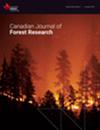A quantile regression approach to model stand survival in Chinese fir plantations
IF 1.5
3区 农林科学
Q2 FORESTRY
引用次数: 1
Abstract
The development of stand survival models can provide an important basis for the sustainable management of forest resources. In a new approach developed in this study, parameters of four survival quantile regression models were predicted from a quantile associated with a current stand density. The curves from these quantile regression models were then used to project future stand density for that stand. A three-fold cross-validation revealed that the quantile regression approach outperformed the least squares method based on three evaluation statistics, especially for longer projection lengths. These results were consistent for all four survival models evaluated. The best survival model is Clutter–Jones model, without constraints, but its ln( N)–ln( Dq) trajectories ( N = stand density and Dq = quadratic mean diameter) from the quantile regression showed the linear self-thinning trend.杉木人工林林分存活模型的分位数回归方法
林分生存模型的建立可以为森林资源的可持续管理提供重要依据。在本研究中开发的一种新方法中,根据与当前林分密度相关的分位数预测了四个生存分位数回归模型的参数。然后使用这些分位数回归模型的曲线来预测该林分的未来林分密度。三次交叉验证表明,分位数回归方法优于基于三个评估统计的最小二乘法,尤其是对于较长的投影长度。这些结果与评估的所有四个生存模型一致。最佳生存模型是无约束的Clutter–Jones模型,但其分位数回归的ln(N)–ln(Dq)轨迹(N=林分密度,Dq=二次平均直径)显示出线性自稀疏趋势。
本文章由计算机程序翻译,如有差异,请以英文原文为准。
求助全文
约1分钟内获得全文
求助全文
来源期刊
CiteScore
4.20
自引率
9.10%
发文量
109
审稿时长
3 months
期刊介绍:
Published since 1971, the Canadian Journal of Forest Research is a monthly journal that features articles, reviews, notes and concept papers on a broad spectrum of forest sciences, including biometrics, conservation, disturbances, ecology, economics, entomology, genetics, hydrology, management, nutrient cycling, pathology, physiology, remote sensing, silviculture, social sciences, soils, stand dynamics, and wood science, all in relation to the understanding or management of ecosystem services. It also publishes special issues dedicated to a topic of current interest.

 求助内容:
求助内容: 应助结果提醒方式:
应助结果提醒方式:


